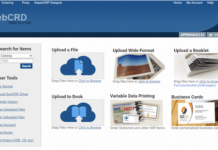As cloud computing makes its way onto the agenda in boardrooms around the globe, practical examples of its implementation in a business-to-business environment have, until relatively recently, been a bit thin. Consumers seem happy enough for the likes of Facebook and Google to hold virtually all of their personal data, but historically there has been resistance from businesses to share data in this way.
While the recent emergence of web-based file hosting and collaboration services such as Drop Box, SharePoint and Huddle indicate signs of change, much resistance remains, particularly in more traditional industries such as printing. Printers that are used to working with large, often commercially sensitive, information are hesitant to transfer files over the Web. They also believe that the sheer volume of information with which they work is not suited to cloud computing — and they are not alone. Many business people remain cautious about allowing one of their most valuable assets, data, to be shared and stored in the cloud.
Yet the benefits of cloud computing to the printing industry are compelling, especially at a time when margins are small and overhead is swelling. The cloud offers access to new marketplaces. It also enables the ability to test new applications and offer new products, services and ideas to niche customers without worrying about capital outlay. Cloud users can focus on what brings value to their business, rather than on what IT to purchase. The cloud also provides the ability to pay only for what is used – known as ‘On-Demand’ – providing scalability and flexibility.
So what’s the catch? And if the cloud is really such a panacea, then why hasn’t every business embraced it fully?
The answer to both questions centres on trust. Printers want to see practical examples of how the cloud works and how their peers are using it before committing to change.
What’s surprising is that they don’t have to look very far because the cloud is already a feature of the print industry in all but name. Web-to-print, essentially a cloud-based service, is already widely used by many print and print management firms for certain types of work. What these Web-to-print users have recognised is the Web’s potential for opening up new markets and revenue streams by making it easier for the customer to buy – a key benefit offered by the cloud in general.
One company that spotted the potential of the cloud for the print industry early on was Cape Town-based Personera. The firm, which offers a personalised products platform for Facebook users, was originally looking for a way to reduce the high bandwidth cost of sending large PDF files (regularly exceeding several gigabytes) to printers around the world. After extensive research into the available technologies, Personera developed an internationally scalable solution compatible with Xerox’s iGen digital production presses for crunching down file sizes to just a few megabytes.
The solution works by sending artwork and templates to a print house once. The items are then kept as reusable objects which only need to be processed once. Variable data is then sent to the print house in the form of text, photos and coordinates, and the final products are assembled ready for printing.
With this efficient network printing model in place, Personera began exploring its online options. It quickly recognised that there were many new cloud-based marketplaces, such as social networks, that are ripe with user information. Developers could easily extract this data to offer value-added services, assuming those users chose to ‘opt in’. As a result they launched a Facebook wall calendar in 2009. Users click on a Facebook Connect button from the Personera landing page, select a theme, and drag and drop their photos. The system can also insert all friends’ birthdays automatically, and users can even add their own events and dated notes. Print runs occur on-demand at the site closest to the user, as in Personera’s original business model.
This model is just one way in which printers can tackle bandwidth issues in the cloud by using the available technology to remotely deliver certain elements of data, saving time and resources. Cloud is clearly not the right delivery mechanism for all print projects, but innovators within the industry will continue to find ways in which it can be used effectively, without ever needing to compromise security. This is going to be much more of an organic adoption process than an overnight change, but the rewards will be greatest for those with both the courage and the ingenuity to try new ways of working in the first wave.





















